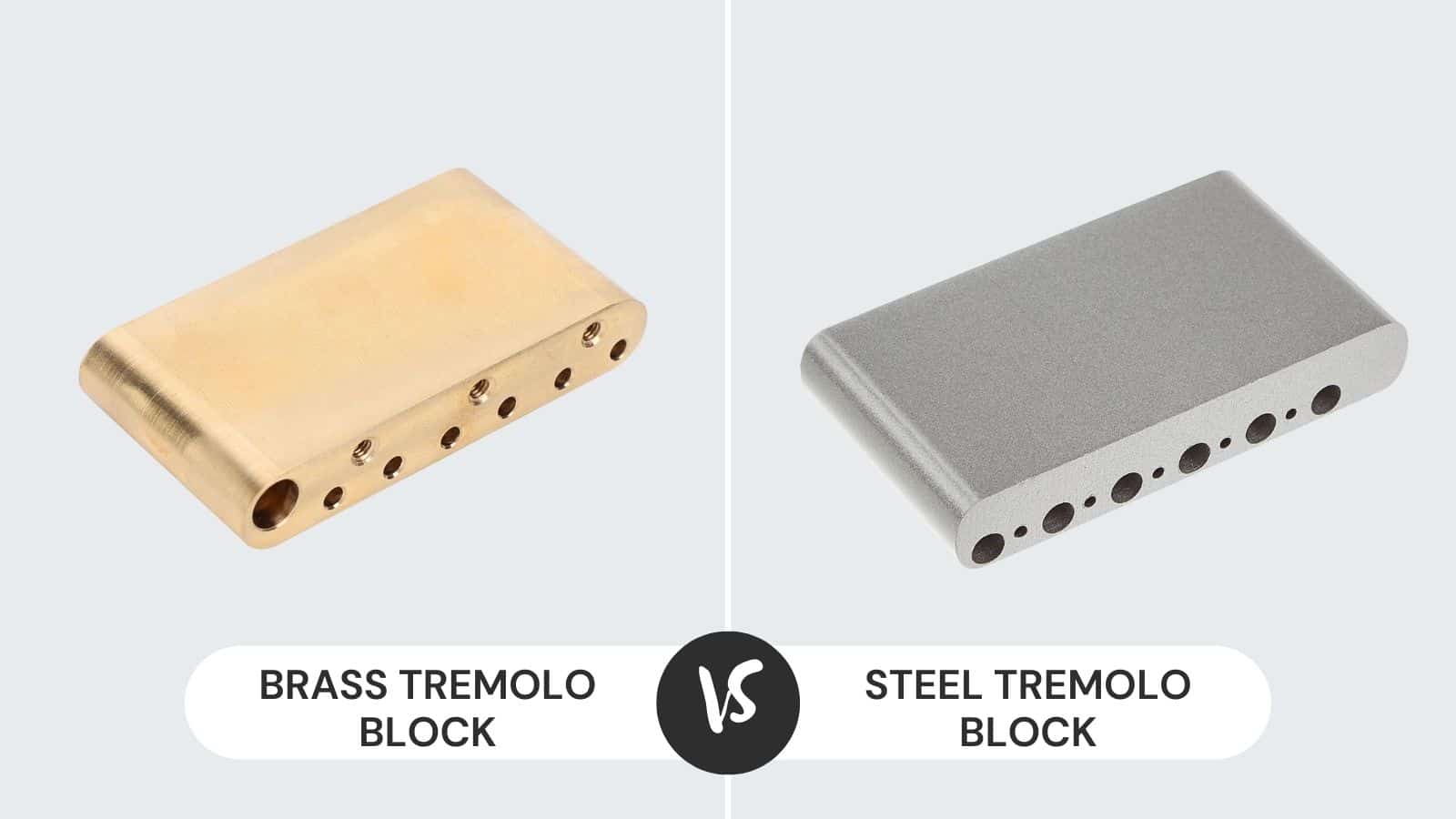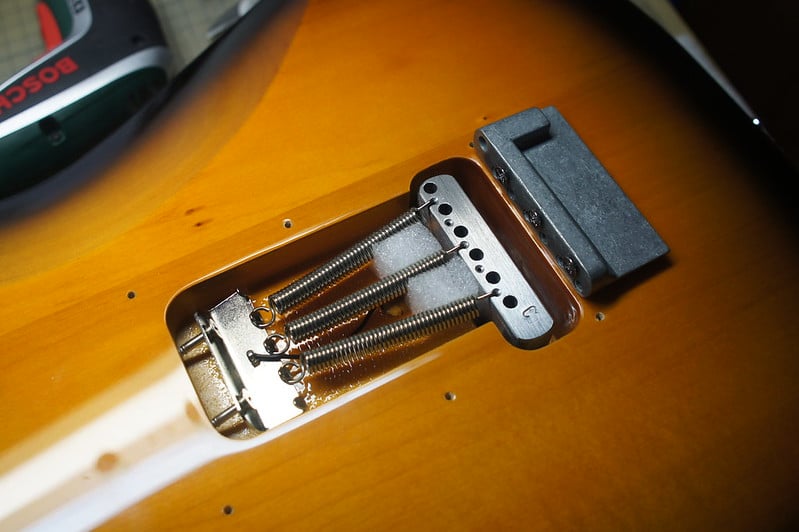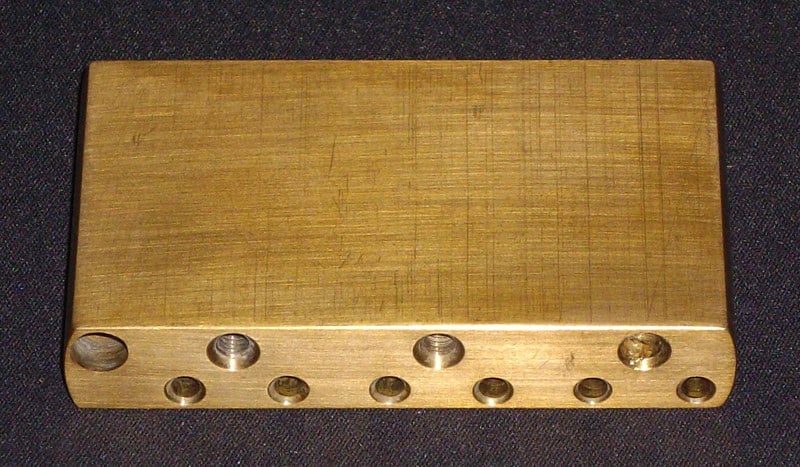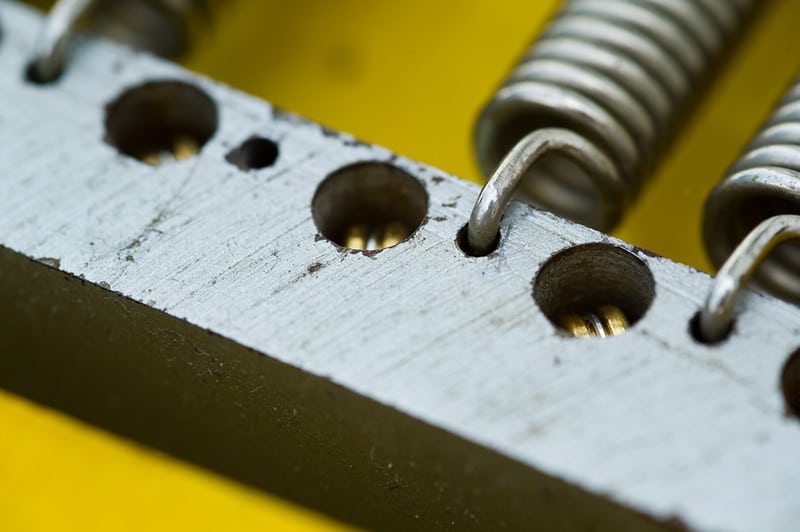
Tremolo blocks are an important part of the guitar that are located at the backside of the bridge. If you want to find out where exactly a tremolo block lies, turn over your guitar and get rid of the cover.
You can see a piece of metal in a solid block form and a rectangular shape. That’s a tremolo block.
It also lets the strings pass through it and apparently shows the string-through-body construction of the guitar. However, the basic function of the tremolo block is to hold the tremolo strings in one place.
At the same time, the attachment of the strings is also with the claw and that claw has a sturdy attachment to the body of the guitar. This is why the requirements for a tremolo block are thickness and strength.
Comparing The Brass vs Steel Tremolo Block
| Features | Brass Tremolo Block | Steel Tremolo Block |
|---|---|---|
| Tone | Warm | Bright |
| Weight | Comparatively lighter | Heavier |
| Sustain | Less | More |
| Comfort | Less | More |
| Common Use | Less | More |
There is a wide range of materials that can be used for the construction of tremolo blocks. However, brass and steel are the most commonly used building materials.
Of these two, steel is used a lot. The use of brass is mostly reserved for the vintage-style Strats.
As the strings pass through the tremolo block, the latter has no such impact on the tone. But that doesn’t mean it has no purpose whatsoever.
Steel Tremolo Block
As the name clarifies, the steel tremolo block uses steel for its construction. Although it has a silver color, you can still paint it in various colors as per your desired design experience.
Strat-style guitars mostly use steel tremolo blocks. When set in the comparison with the default stock tremolo blocks, the steel ones are solid metal chunks. They also weigh more than the typical tremolo blocks.
Acoustic Properties
It’s not just the physical properties that are a unique factor about steel tremolo blocks, they also outshine the rest of tremolo blocks in terms of their excellent acoustic properties.
Steel is usually known for the addition of a brighter tone. The vibration of the string takes place in such a manner that the mix gets more high ends.
Weight
When compared with the brass tremolo block, the steel tremolo block is lighter in weight. You get a lot of edges to the probability because their weight is less than brass’s. Your guitar is also free of strain resultantly.
Sustain
It is also quite noticeable that the sustain offered by the steel tremolo blocks is more prolonged than the others. However, it’s subjective because everyone cannot have the same experience with it.
There are a bunch of other guitar attributes and features that affect the sustain. However, the changes in the tone are very clear to hear.
Weight And Action
There are also several differences between the steel tremolo blocks and the stock ones. The weight of steel tremolo blocks is more than that of stock blocks. As far as the action is concerned, it is also different.
Tension
After you are done with the installation of a steel tremolo block, make sure you check the tension. In order to increase the tension, the tremolo can have an addition of an extra spring.
The tension is bound to increase with it but it also accompanies discomfort. Therefore, it’s a personal preference whether you want to add an extra spring or not.
The composition of the steel tremolo block is thinner as compared to that of the brass tremolo block. This makes the steel block an ideal option for playing music genres like pop, rock, and blues.
Brass Tremolo Block
The use of brass tremolo blocks is not quite common but still, they have their own uses. Their properties differ in many ways from that of steel tremolo blocks.
Most guitar luthiers prefer the use of brass for the tremolo blocks because it not only increases the warmth but also clarity.
The combination of warmth and clarity is very rare and it is only achievable through the brass tremolo block.
Weight
Brass wins over steel not only in being heavier but also in being thicker. No matter how subtle the difference in weight and thickness is, it is still noticeable.
When compared with a conventional sustain block, the brass tremolo block is definitely larger. Thus, it holds the power to put a limit on the upward level of the tremolo.
You can smoothly rest it against the body but the configuration has to be a blocked bridge. If the required configuration of the setup is a floating bridge, route the brass tremolo block in the spring cavity.
Tone
The features of a brass tremolo block have a great impact on the tone of the guitar. The chord clarity is potentially strengthened with the brass tremolo blocks.
As far as the individual tones are concerned, they are also beefed up with the brass. In addition to all these improvements, you also get the feel of a vintage sound that has been time-tested.
There is also a certain mellow accent associated with the guitar that uses brass tremolo block. The latter is also capable of darkening the output sound.
Comfort
As mentioned earlier, the brass tremolo blocks weigh more than the other blocks, it is recommended to add an extra spring on the block.
Experiments reveal that the addition of two or three springs adds too much to the mellowness of the action. If you have added four springs, you get more comfort while pushing down the tremolo arm.
Comparison Of Brass And Steel Tremolo Block
Just like we mentioned earlier, every type of tremolo block carries a different experience for the user. But there definitely are some instructions to be kept in mind while using different materials.
Tone
The tone produced from the brass tremolo block is darker and it carries a great sustain. However, the steel tremolo block offers a different tone which is brighter but the attack is more.
When the brass tremolo block and the steel tremolo block are compared with the stock tremolo block, the former two stocks appear as an upgrade.
However, the upgrade is minimal and the investment it requires is very small. You are bound to get solid results from it.
Action
Another name for the tremolo blocks is sustain blocks. No matter how wonderful the sustain blocks are, they can’t do wonders on their own.
Tone doesn’t result from the impact of tremolo blocks. Various other factors are also involved in it. However, the change of a tremolo block is a great help.
It’s not just the tone that gets changed. There is a significant change in the feel of the tremolo action as well. Let’s take an example where you add more weight.
It can result in smoother action. If you need to balance it, just add an extra spring to it. However, the better choice is to push it down with a tremolo block that weighs more.
Holes
For the ball ends of strings, the stock tremolo blocks contain deeper access holes. You might be thinking how it makes sense because there is no such impact of the block on the tone.
But if the holes are shallow, more and more strings can stay connected with the block. Therefore, it has more impact on the tone as compared to the stock tremolos.
Conclusion
If you want to add a mellow accent to the sound of your guitar, you must pick a brass tremolo block. However, if you go for the acoustic properties, the steel tremolo block offers more brightness to the tone.




Would be nice to compare the stock Zinc, Steel & Brass (there is also Aluminum, Copper, Platinum & Titanium blocks) for hardness of the metals an how that might affect the warmth & chime of the Stratocasters tone.
I get that they are going to weigh based on the dimensions of the block as well there is length, width & depth that varies usually from 35-42 mm deep depending upon which brand of Strat you have. One has to get one that fits, so string spacing matters, depth of the guitar matters & so does Tremolo plate screw spacing when replacing the particular block.
I don’t think anyone cares what color you can paint a steel one. Metal appearance is another aspect that only matters if the plastic Tremolo cover has a slot to see the block from the bottom of the guitar or whether the Tremolo cover is ever put back on.